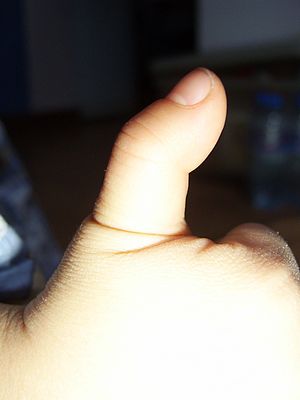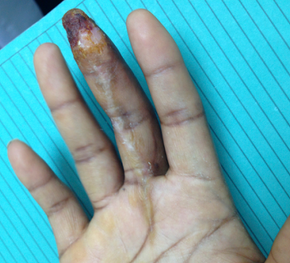Tenosynovitis
| Tenosynovitis | |
|---|---|
| Other names: Tendinitis, tendovaginitis, tendinosis[1] | |
 | |
| A case of congenital trigger finger, a type of tenosynovitis, in a 3 year old | |
| Specialty | Plastic surgery, orthopedics |
| Symptoms | Pain, swelling, inability to fully straighten the joint.[2] |
| Types | Infectious, noninfectious (de Quervain tendinopathy, intersection syndrome, trigger finger)[2][1] |
| Differential diagnosis | Felon, joint infection, herpetic whitlow, cellulitis[3] |
| Treatment | Based on cause[2] |
Tenosynovitis is inflammation of a tendon and it fluid-filled sheath.[2] Symptoms typically include pain, swelling, and inability to fully straighten the joint.[2] Tendons in the hand, wrist, and foot are most commonly affected.[2]
Tenosynovitis may be infectious or noninfectious.[2] Infections may occur due to injury, such as a cut or bite, or spread from elsewhere in the body.[2] Noninfectious types include de Quervain tendinopathy, intersection syndrome, and trigger finger (stenosing tenosynovitis).[1] Risk factors for the noninfectious types include overuse, rheumatoid arthritis, and psoriasis.[2]
Cases due to infection of the flexor tendons require rapid treatment.[3] Mild cases may be managed with intravenous antibiotics and splinting; while more severe cases also require surgery.[3] Noninfectious types may be treated with NSAIDs, splinting, or corticosteroid.[1][2] Up to 3% of people may have trigger finger.[2]
Signs and symptoms

Symptoms typically include pain, swelling, and inability to fully straighten.[2] Tendons in the hand, wrist, and foot are most commonly affected.[2]
Cause
Infectious
Infectious tenosynovitis is an infection of the synovial sheath. The flexor tendons of the fingers are most commonly involved. It is usually caused by trauma, but bacteria can spread from other sites of the body. The disease can also affect the extensor tendons.[4] The infection can be mono- or polymicrobial and can vary depending on the nature of the trauma.
The most common pathogen is Staphylococcus aureus introduced from the skin.[5] Other bacteria may include Pasteurella multocida (associated with animal bites), Eikenella spp. (associated with IV drug use), and Mycobacterium marinum (associated with wounds exposed to fresh or salt water).[6] Additionally, sexually active people are at risk for hematogenous spread due to Neisseria gonorrhoeae (see infectious arthritis).
Noninfectious
Noninfectious causes include stenosing tenosynovitis, intersection syndrome, extensor pollicis longus (EPL) tenosynovitis, de Quervain's and fourth compartment tenosynovitis.[1]
Diagnosis
Diagnosis is typically based on a person's history and physical exam. Aspirated fluid can be cultured to identify the infectious organism. X-rays are typically unremarkable but can help rule out a broken bone or a foreign body.[7]
See also
References
- ↑ 1.0 1.1 1.2 1.3 1.4 Travis, D Blood; Nathan T, Morrell; Arnold Peter, C Weiss (29 March 2016). "Tenosynovitis of the Hand and Wrist". Journal of Bone and Joint Surgery. 4 (3): e71–e78. doi:10.2106/JBJS.RVW.O.00061. PMID 27500430. S2CID 29942149.
- ↑ 2.00 2.01 2.02 2.03 2.04 2.05 2.06 2.07 2.08 2.09 2.10 2.11 2.12 Ray, G; Sandean, DP; Tall, MA (January 2022). "Tenosynovitis". PMID 31335044.
{{cite journal}}: Cite journal requires|journal=(help) - ↑ 3.0 3.1 3.2 Hermena, S; Tiwari, V (January 2022). "Pyogenic Flexor Tenosynovitis". PMID 35015439.
{{cite journal}}: Cite journal requires|journal=(help) - ↑ Small, LN; Ross, JJ (December 2005). "Suppurative tenosynovitis and septic bursitis". Infectious Disease Clinics of North America. 19 (4): 991–1005, xi. doi:10.1016/j.idc.2005.08.002. PMID 16297744.
- ↑ Moses MD, Scott. "Suppurative Tenosynovitis". www.fpnotebook.com. Archived from the original on 2019-02-07. Retrieved 2020-12-26.
- ↑ Tsai, E; Failla, JM (May 1999). "Hand infections in the trauma patient". Hand Clinics. 15 (2): 373–86. PMID 10361644.
- ↑ Sexton, MD, Daniel. "Infectious Tenosynovitis". Uptodate. Archived from the original on 2020-02-15. Retrieved 2020-12-26.
External links
| Classification | |
|---|---|
| External resources |